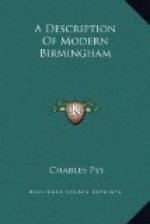ST. PHILIP’s CHURCH.
The scite of the church-yard, parsonage, and blue-coat school was the gift of Mrs. Elizabeth Phillips, and her son and daughter in law, Mr. and Mrs. William Inge, the ancestors of William Phillips Inge, Esq. without stipulating for the presentation. This superb edifice was designed in the year 1710, by Thomas Archer, Esq.[3] who was gentleman of the bed chamber to her majesty Queen Anne, and who, it is universally allowed by all who have taken particular notice of this building, was possessed of superior abilities, and a refined taste as an architect. An act of parliament being obtained for the erection of it in the year 1709, the same was begun in 1711, under a commission, granted to twenty of the neighbouring gentry, who were appointed by the bishop of the diocese, under his episcopal seal; whose commission was to expire twelve months after the church should be erected. It was consecrated in the year 1715, but not finished till 1719, when the commissioners resigned their authority into the hands of the diocesan, in whom the presentation rests.
[Footnote 3: He also designed the church of St. John, in Westminster.]
The money expended by the commissioners, two years after the consecration, did not amount to quite L5000; but then it must be recollected, that a very large proportion of the materials were given, and conveyed to the spot free of expence. A considerable sum of money being left unpaid; this circumstance was made known to his majesty, George Ist, by the intercession of Sir Richard Gough, when he, in 1725, generously contributed six hundred pounds towards the completion of it; and the inhabitants, to express their gratitude for this favour, affixed the crest of Sir Richard Gough, as a vane, on the top of it.
The urns upon the parapet of the church, which contribute in a considerable degree to its appearance, were placed there when the celebrated Baskerville was church-warden, in the year 1750. The organ posseses full tone and great power; the paintings, mouldings, and gildings are superb, and do great credit to those who were employed. Under the centre of the church there is a capacious vault, which extends the whole length of it. The dome in some degree resembles that of St. Paul’s, in London, and in the tower underneath it are ten musical bells, and a set of chimes that play a different tune every day in the week, at the hours of one, four, seven, and ten; which tunes shift of themselves by means of the machinery. On the south side of the tower there is a meridian line affixed, by means of which, if the sun shines, the hour of twelve is known to a certainty. This elegant pile of building has been examined with the greatest minuteness, by numerous architects, both within and without, and by all of them declared to be the work of a master; it being equally convenient as it is elegant. The church-yard, by which it is surrounded, corresponds with the building; its area contains four acres of




